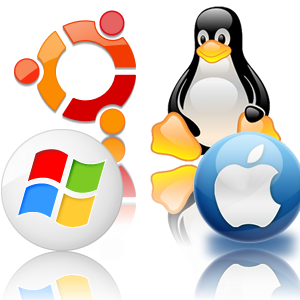
The evolution of operating systems or how it was and how it will be.
Introduction
Not many people know and remember what started the history of computer software – operating systems. Recently computer technologies made a significant leap forward and soon it will be impossible to imagine our lives without a computer. But without operating system computer is only a chipset. On the basis of the operating systems is working all programs that we use, and firstly, speed and productivity of our work on the computer will depend on the OS abilities.
A modern PC consists of one or several processors, RAM, drives, printers, keyboard, mouse, monitor, network interfaces and other various input/output devices. As a result, we can it turns out to the complex system. If each programmer, who creates an application, will be delving in all “ins and out” of these devices, he wouldn’t write even a line of code. Moreover, managing of these components and their optimum utilization is a very difficult task. For this reason, computers are equipped with a special layer of software called operating system, tasked with managing user programs all the resources of hardware.
The first OS

GM-??? was the first operating system for computers. It was created in 1956 by Robert Patrick from General Motors and Owen Mock from North American Aviation. It was based on a system monitor and worked on large machines. The main function of GM-??? — is an automatic execution of a new program when old had completed.
The occurrence of PLATO
The system PLATO was developed in 1972 and has had a number of innovations, such as orange plasma panel. It included a memory and some functions of raster graphics. PLATO’s plasma display supported a possibility of the fast rendering of vector lines. The most innovations which were created with PLATO OS become a basis for developing new computer systems. For instance, some technologies were transposed and improved by Apple.
The occurrence of UNIX
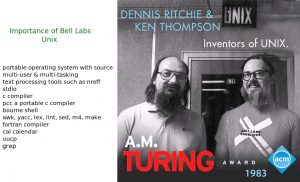
The first UNIX system was developed in 1969 in the unit Bell Labs of AT&T company. Since then were created a large number of various UNIX systems. There are some of the distinguishing features of UNIX-based systems:
1. Using of text files for configuration and management of system;
2. The increased usage of utilities launched in the command prompt;
3. An interaction with the user via virtual device – terminal;
4. The submission of physical and virtual devices as files.
Ideas underlying the UNIX were a major influence on the development of computer OS. Nowadays UNIX based systems considered as one of the most historically important OS. This operating system publicizes the idea of a hierarchical file system with an arbitrary depth of nesting.
Linux
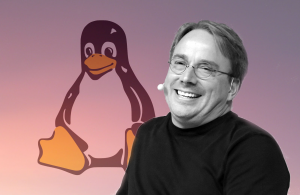
Linux was created in 1991 by Linus Torvalds, a Finnish student. The fact that Linus after creating the OS had posted the source code of this OS into the Internet was a decisive factor in the fate of Linux OS. The Internet was not yet widespread in 1991 as nowadays, but it was mostly used by people who have sufficient technical training. And from the outset, Torvalds had received several concerned reviews with the proposal to help in the development and he’s agreed; and after six months hundreds of programmers were joined to development, later – hundreds of thousands of volunteers. Due to the fact that Linux source code is distributed freely and publicly available, a large number of independent developers take care about the matters of system development from the beginning of the project called Linux OS.
MS-DOS
MS-DOS — a commercial operating system designed by Microsoft for IMB PC-compatible PCs. MS-DOS is working in the real-time mode on processor x86. There is realized the only one-time implementation of one program. MS-DOS was designed so that users can easily to replace embedded interpreter with outside interpreters of the command prompt, for instance, 4DOS.
Windows, of course, it is
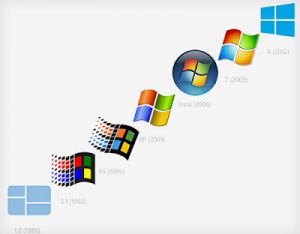
The first version of OS Windows was appeared in 1985 and was not appreciated by the users and also ignored by them. Perhaps it was because OS was only complemented the capabilities of DOS, being, in fact, the graphic shell and the superstructure over a set of MS-DOS.
Windows has been modified over time, was appeared a new complete graphics, users was deprived from seeing system files, also have been overcome the barrier of multitasking that allows running 2-3 programs at the same time. In 1992 when was created Windows 3.1, according to many users and professionals, new features of the OS were appreciated. With version 3.1 of Windows, this OS get a 32-bit access to the hard disk.
On July 25, 1998, new Windows 98 had expanded into consumer’s market. The main advantages of this version in comparison to latest versions were: full integration with the Internet, the more improved interface management, new processor Pentium II, graphics portal AGP, USB bus.
In parallel with the previous one, there is began a development of a Windows XP system, where it was finally decided to abandon the 16-bit in the core system and go to the 32-bit, with a new architecture and structure. We should note the benefits of the new system: this is the first system with a fully customizable interface, with the implementation of intelligent menu “Start”. Also, there was redesigned management dashboard which allows controlling a lot of functions of your PC.
Do you remember Windows Vista? Forget about it, because it’s the worst variant of Windows versions. It’s also called and performed as “a general rehearsal” before Windows 7. It seemed that the good qualities of the new system were cause an interest within users. Innovations such as built-in search, three-dimensionality of the Aero interface with beautiful screensavers, good protection — nothing worked, everything is made so poorly, according to users.
Windows 7 wasn’t so different, it has a new interface which was copied from Vista. There are a lot of editions of Windows 7, released by Microsoft: Starter Edition, Home Basic, Home Premium, Professional, Enterprise and Ultimate. Windows 8, unlike its previous versions, Windows 7 and Windows XP, uses a new interface called Modern (Metro). Also, the system has a desktop, but it’s a separate app.
Mobile OS
Nowadays the increasing interest is shown within users to the smartphones based on various OS: Windows Phone, Bada, Symbian, Android, iOS. The most popular ones are iOS and Android.
iOS
iOS — it’s a mobile OS based on Linux core and developed by Apple. It was firstly released in 200
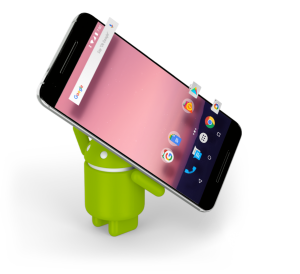
7 for iPhone and iPod Touch. Today this OS is preinstalled on all Apple devices. Such innovations as mobile browser Safari, visual voicemail and virtual keyboard placed iOS one of the most popular OS for smartphones.
Android
Android – it’s an OS that grows very fast, developed for smartphones (initially for communicators (iPhone and its touchscreen had changed the opinion of Google)).
It is a simplified version of the similar Windows and Linux systems used on desktop PCs and laptops, oriented for the touchscreen. The Android platform consists of the operating system, interface, binding software and powerful applications.
Google Chrome OS (cloud ?S)
Chrome OS is positioned as the operating system for various devices, from small netbooks to full-size desktop systems
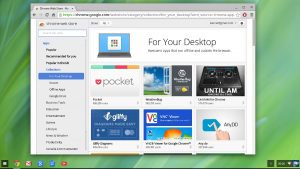
and supports x86 and ARM processor architectures.
New Google Chrome OS has open source code, based on an optimized Linux kernel and controlled by the Chrome browser. The main feature is the dominance of web applications over conventional functions of the OS. A key role is given to the browser in that case.
The strategy of creating a new product involves undemanding usage of PC resources architecture used to access to the Internet.
All applications which started in the OS — mostly web-services. In fact, all actions taking place on the PC run the Internet — there is no need to install any offline apps. In this regard, the work in Chrome OS doesn’t require the availability of powerful PC resources because all processes are performing not on the PC, but on the server or related services.
The predictions of a fortune-teller
User’s operating systems is becoming something like web-browser installed on the “bare hardware”. Modern classic interface (developed in Xerox PARC and firstly introduced almost 30 years ago by Apple) would recede into the past. Many modern composite parts of the OS will be simply not necessary; others will “go away” from the user, and will become a service API for programmers. The main task of the OS will be providing the ability to start the client part of cloud services. And the benefits which have a Microsoft OS in the modern world will be greatly reduced. They will have to invent new ways to bind a user and programmers in the new environment, more competitive, compared to the present.
But a lot of that depends on the decisions, successes and failures of major software companies such as Microsoft and Google. However, unlike the evolution of software that we saw in the nineties and the two-thousandths, the new evolution is more less dependent on hardware manufacturers, and more — from manufacturers to end users.